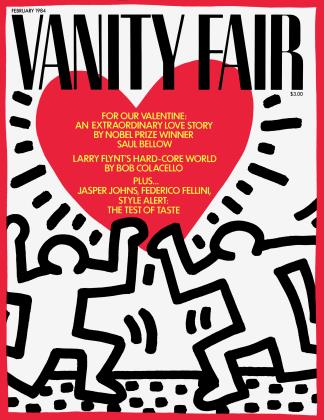Sign In to Your Account
Subscribers have complete access to the archive.
Sign In Not a Subscriber?Join NowART
TRACKING THE MARVELOUS: A LIFE IN THE NEW YORK ART WORLD, by John Bernard Myers (Random House). In these memoirs Myers chronicles his years as puppeteer, magazine employee, and art dealer. The book is affectionate gossip—friends and acquaintances like Joseph Cornell, Helen Frankenthaler, Peggy Guggenheim, and Marcel Duchamp travel in and out of Myers’s life, with love affairs, fur coats, and eccentricities trailing behind. When Myers does spend more than a gadfly moment on a subject (like painter Robert Goodnough), the result is a sensitive portrait. He manages to be naive, bitchy, and savvy all at once, and the art world has never been so frankly described.
MIMI THOMPSON
V.F. RECOMMENDS
Exhibits
MAX BECKMANN
Haus der Kunst, Munich, February 25—April 29, traveling show.
TERRY WINTERS
Sonnabend Gallery, New York, February 4-25.
Books
PAINTERS PAINTING
Emile de Antonio and Mitch Tuchman (Abbeville).
PICASSO: THE LAST YEARS, 1963-1973 Gert Schiff (Braziller).
ROMANTICISM AND REALISM: THE MYTHOLOGY OF NINETEENTH-CENTURY ART Charles Rosen and Henri Zerner (Viking).
MALCOLM MORLEY (The Brooklyn Museum, February 18—April 15). Malcolm Morley is a painter’s painter: he can move the paint around the canvas with a wildness and a control that many envy and few achieve. And with the recent success of the global neoexpressionist “cabal,” Morley’s work appears particularly newsworthy.
In the mid-’60s Morley’s photo-realist paintings brought him to the art world’s attention. He used a grid to paint these pictures, but eluded. the killing slickness of much photo-realism and kept his sense of the absurd. One picture-postcard painting from 1971, Kodak Castle, cites its own gag with a peeled corner and a Kodak label.
His nonconformity and constant imaginative strength have carried him through many stylistic changes. By the mid-’70s both subject matter and painting style had taken on an expressionist tone. The most recent work in this exhibition (organized by the Whitechapel Art Gallery in London) contains much aggression and allegory as well as a sense of materiality and lush color. Morley exhibits a bit of tropical paranoia in mad jungle scenes, where Fiercely colored Indians intermingle with flamingos and a speared Nazi flag. This work is important to see—for its power of individual thought rather than the presence of a group mind.
M.T.
 View Full Issue
View Full Issue












Subscribers have complete access to the archive.
Sign In Not a Subscriber?Join Now